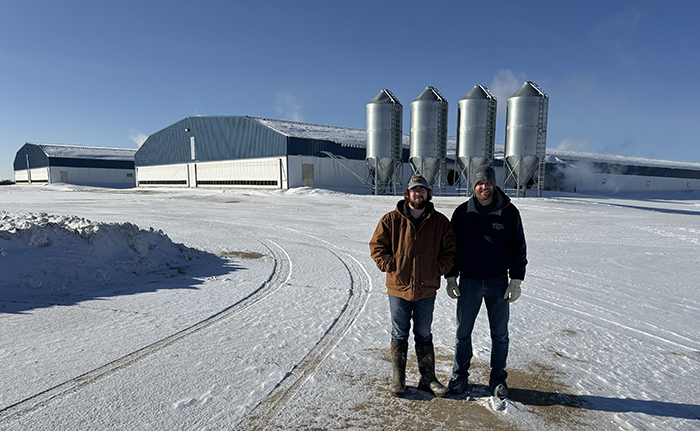Blowers Township birthing center continues to grow
News | Published on February 25, 2025 at 2:21pm EST | Author: frazeevergas
0
Otter Wings LLP Onsite Manager Ben Alberg, left, and Preferred Capital Management CEO Chase Stahl brave the cold at the large swine facility southwest of Sebeka Monday, Feb. 17. The facility breeds enough animals to provide pork to about 10,000 people per year.
By Matthew Johnson
Reporter
Otter Wings (OW) LLP, a swine birthing center located west/southwest of Sebeka in Blowers Township of East Otter Tail County (OTC), remains fully operational, but at nearly twice the number of animals as when it became fully operational in the spring of 2020.
The original number of animals was 2,500 that year but, after a permitting process approving more, the facility expanded to accommodate nearly 5,000 animals in the fall of 2021, confirmed Chase Stahl. Stahl, who said the facility was initially established in 2019, is a Fairmont, Minn., veterinarian and the CEO of the Fairmont-based Preferred Capital Management (PCM), which initiated and oversees management of the operation.
He said the 2021 expansion also resulted in twice the amount of farrowing and farrowing crates went from 416 to 832. Plus, the breeding barn was added with 2,160 crates, as well, Stahl reported.
The facility is now responsible for producing enough piglets every week that eventually results in around 533,000 pounds of pork a year. Given that the average American eats about 53 pounds of pork a year, said Stahl, the facility and subsequent down-streaming finishing growth process produces enough pork to feed about 10,000 people per year.
Currently, about 480,000 pigs are killed per day in America based on 2025 weekly USDA statistics.
PCM specifically selected the OW location due to this area’s relatively low pig density, which means less exposure to potential pig viruses, said Stahl. Plus, OTC is a pro-agriculture county that is “great to work with,” he said.
Much of the operation is devoted to keeping the sows healthy including water that goes through a disinfecting process to help prevent disease/sickness in the pigs.
“These sows have as good or better water than what we have,” he said. “Sows are amazing in what they can do today.”
He noted that sows can wean 13.5 or more piglets per weaning event.
The process includes shipping weaned piglets to three independent farmers in the Martin/Jackson County area where they are fattened up before going to Hormel in Austin, Minn. Ultimately, all the pigs farrowed at OW that meet the qualifications of Proposition 12 go to the California pork market.
“It’s a niche market,” he said. “We have an audit every year to make sure we’re in compliance.”
The operation, managed by PCM, has three owners. A farmer in his mid-50s in the Martin/Jackson counties area is majority owner and two brothers in their early 40s own the other third. Also, there is a lease agreement at OW between Haybrook/PCM and OW.
“Haybrook owns the sows, Otter Wings owns the brick and mortar (facilities),” said Stahl.
In addition, there are two similar sow birthing centers of about the same size as OW near Leader, Mnn., which is known for its pig races.
To support the extensive OW operation, the facility basically has four large barns. There is the gestation barn, the farrowing barn, the breeding barn and the Gilt Development Unit (GDU). Stahl said the gestation and breeding barns are twin barns in terms of size each measuring 122.7 feet wide and over 500 feet long. The GDU, he said, is able to receive gilts and grow and acclimate/vaccinate them prior to breeding.
Another favorable aspect of the facility is a specially engineered, state-of-the-art, ventilation system incorporating airstacks that help minimize odors and contain them primarily to the facility itself.
Ben Alberg of Bluegrass, a Haybrook/PCM employee, has worked with the OW operation close to four years now. He has been and continues to be the on-site OW manager for about the past two years. Stahl said Alberg is consistently staying on top of the production schedule.
“Ben’s weaning 2,700 pigs per week,” he said.
The facility, which runs 24/7/365, employs 15 total full- and part-time facility workers from within about a 15-mile radius.

